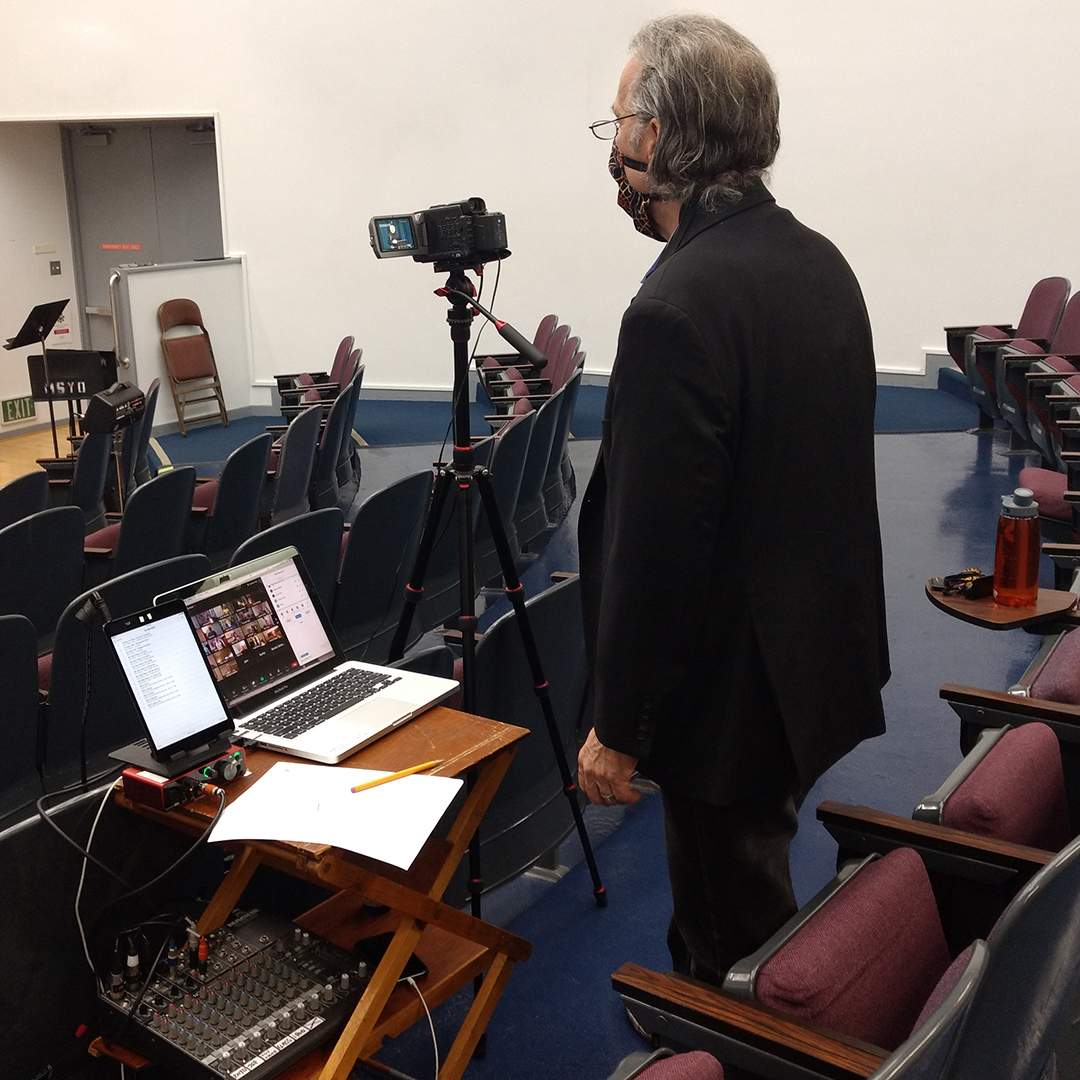This is the final piece of a multiple part series on College of Marin’s (COM) Performing Arts Department and how they have evolved their programs into the remote learning environment to provide students worthwhile experiences and relevant performances that show why COM’s faculty are pioneering visionaries.
 Striking a Chord in Instruction
Striking a Chord in Instruction
In an ideal world, musicians perform together in the same room so they can listen to each other and play off each other’s energy. The unique dynamic and je ne sais quoi magic that sparks during live performances is one of the reasons concerts have been so popular and successful for centuries. In a COVID-19 world, ensemble, choir, jazz, and orchestral music is all but impossible.
Musicians cannot truly play live together over Zoom as delays, lags, and interruptions are inevitable. Milliseconds of delay are doable over work meetings, but for music performance, it amounts to a Grand Canyon of difference.
The Chamber Singers at COM, however, have found a new program that allows musicians and performers in relatively close proximity to continue to perform together. They have been using an open-source software program called JackTrip out of Stanford University which significantly reduces the ‘latency’ or delay over video calls by prioritizing audio data in a very efficient way over the internet. (The software does have limitations, however. Anything beyond 500 miles of distance between players, and the latency becomes, again, untenable.)
The hardware necessary isn’t cheap though—$252 per singer or $150 for the box. Thanks to the community’s support of the department over the years, choral director Boyd Jarrell said they was able to make the necessary expenditure to allow learning to continue.
Other areas of the department have shifted their focus away from live performance. COM Jazz Instructor Casey Carnahan worked to deepen his students’ knowledge on specific areas within jazz, choosing to spend an entire semester studying, perfecting, and recording Miles Davis’ classic album Kind Of Blue. Their individual recordings were stitched together into a video for each track. At the end of the term, the class had a series of five YouTube videos, one for each track on the album.
“At the end of the semester, we had the album. I sent everybody a link and it was really pretty cool. I think the students were excited. A lot of them had never heard themselves before on a recording,” Carnahan said. “The first time you hear yourself on an album is always exciting.”
The jazz students, in many ways, were uniquely prepared for the sudden shift in their learning environment. Improvisation and flexibility are a fundamental part of the soul of jazz music.
“You have to be comfortable with changing at a moment's notice and constantly correcting things and going in new directions. That's the spirit of improvisation,” Carnahan said. “And that’s how I've been approaching this year.”
The orchestra, typically trained to seek perfection and uniformity in its performance, has taken notice. Orchestra instructor Jim Stopher said he is modeling the coursework to dive deeper into one particular piece of work, Mozart’s ‘Jupiter Symphony, instead of learning a repertoire as they normally would. Because of that narrower focus, students are encouraged to analyze the music more astutely than they might have pre-pandemic.
“It was their pinnacle,” Stopher said.
COM music instructors have found another positive in the virtual learning environment—the ability to bring in working composers to talk and answer questions about their music with the class. Carnahan was able to have composer Hans Zimmer, who has created over 150 scores for films, such as Rain Man and Wonder Woman: 1984, answer student questions where he may not have had the time previously.
Ella Steinberg, interim director of COM’s Symphonic Wind Ensemble is also bringing in a diverse group of composers to meet with her students. She’s focusing particularly on women and minority composers, typically underrepresented in this field. The ensembles learn a piece from each of the composers before having the composer visit to discuss their music and hear the ensembles play the composer’s piece.
The Future is Full of Crescendos
“The interesting thing that happened this semester—our numbers went up, because people who had been participating talked to people who hadn't been participating and they said, ‘‘Get off it, you really ought to be here!’ And this is not me twisting arms,” Jarrell said. “That's really cool to see when people are talking behind my back and telling other people ‘No, you have to get in here. This is positive. We're learning some music. We're making some things happen.’”
The hope is to get students back on campus and playing together again as soon as it is safe and responsible to do so. Even though the department has figured out workarounds, the technology cannot truly replicate live rehearsals and performances.
“When we return, I'm just going to let the students play. They want to play. They've been listening to people talk for a year now,” Carnahan said. “So, I'm going to take more of a hands-off approach and let them play. I'll give some instruction, but I think people will just need to reconnect. I think that's going to be the role of music when we do finally return to in-person learning: to connect people together, connect the musicians and the audience, and bring everybody back together. I can't wait for that to happen!”
Become part of COM’s contemporary Music program or show your support by donating. All donations go directly to the program and are tax-deductible.
